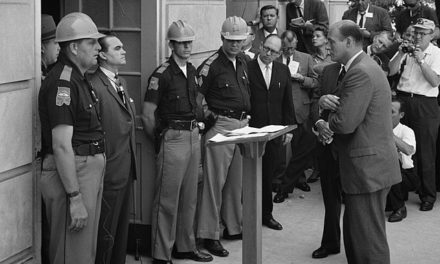Politics 101 calls for politicians to solemnize each year’s budget hearings with the pronouncement that there’s never been one that’s more challenging and difficult.
This year, it just happens to be true.
Troubling trends that have been gathering for 20 years, exacerbated by the last eight years of the Herenton Administration, have landed with a thud on the desks of Memphis Mayor A C Wharton Jr. and Memphis City Council Budget Chairman Bill Morrison, leaving them to make the best decisions from a list of bad choices.
In the past week, Memphis City Council got a dose of reality with presentations at its weekly session and a weekend retreat. One thing is clear: The City of Memphis budget is at the eye of a perfect storm, with all of the crucial trends running in the wrong direction.
Getting the Target Right
In the best of times, it would be difficult to balance the books, but in today’s economic crisis, it will take a blend of tough love and alchemy to make the numbers work. And that would be the case even if city government didn’t have the issue of school funding handing over it.
Mayor Wharton said his emphasis will be on increasing productivity and cutting costs, but already, there are misplaced calls for city government to think of new taxes. Council member Barbara Swearengen Holt Ware already has raised the specter of a payroll tax, an idea that we have supported over the years.
But now is not the time to concentrate on the revenues side of the ledger. The focus this year needs to be solely and directly aimed at expenditures, because before the public is going to support any call for a new tax, city officials must have proven conclusively that it has done everything else possible to tame the budget.
That said, rhetoric about stimulating economic activity with a low-tax environment tends toward jingoism as well. It’s not just about low taxes, because the most successful cities these days aren’t low tax ones. More to the point, it’s about tax value, and making the investments that spark economic growth, particularly start-ups, entrepreneurs and African-American businessese, areas with the greatest returns on investment for Memphis.
As long as City Council allows non-elected boards to over-rely on tax breaks and to give away about $30 million in taxes every year, many of them for low-wage jobs, it has its eye off the ball on economic development because the tax waivers hit the city budget at its heart.
Top to Bottom
But, back to concentrating on the expenditures side of the ledger: It requires a top to bottom review of every part of city government, including every policy and program. More to the point, it should include a look at policies that aren’t in place.
For example, while all of us were worrying about the climbing Shelby County debt, the Memphis debt was tripling as a result of some unprecedented spending during the Herenton years and now rests at $1.2 billion (like the county, the commonly cited debt amount only reflects the principle amount). Meanwhile, as a result of the debt reduction plan put in place by the Wharton Administration there, the county debt has dropped dramatically to $1.5 billion.
Meanwhile, the amount in the city budget to pay for bond debt is within shouting distance of the county budget, which topped out a few years ago and is dropping, thanks to a plan conceived by County Chief Administrative Officer Jim Huntzicker. There’s little evidence that city government has such a plan, but based on Mayor Wharton’s experience in county government, we expect that he’ll try to get a handle on the city’s climbing debt sooner rather than later.
The debt service amount is a financial milepost like operating budgets, but they are driven by volatile factors that do city government no favors this year. With a dependency on regressive tax sources – on real estate and consumption – city budgets rest on a foundation as stable as a line of dominoes. And in the past year, several of them fell over, particularly those affecting property values and consumer spending, setting off a chain reaction that will rumble throughout city budgets.
Tough Trends
With property taxes as the largest source of city revenues, any negative shift can be devastating, and this year, there’s more than one. Already, the median housing value in Memphis is lower than our peer cities except for Birmingham, and that median value took a direct hit with a soft market and with 15% of Memphis housing being vacant.
Meanwhile, consumer spending took a nose dive as people cut back and unemployment climbed to 11%. Of course, the real unemployment rate is more like 33% because of the large number of Memphians who aren’t counted any more.
To add more stability into the revenue mix, Mayor Wharton said he is looking for a better mix of taxes and fees. Compared to its peer cities, Memphis has a low percentage of its revenues coming from fees, and the mayor said he wants to consider if a different mix of fees could reduce the reliance on property taxes.
Mayor Wharton said he also wants to look at the possibility of closing some public facilities. At this point, you don’t need a deep understanding of city finances to get his point. All you need is a map.
The location of public facilities are for another time, and with densities in large parts of Memphis at less than half of what they were 30 years ago, it’s clear that most of the facilities in the urban core are now located at the wrong places, not to mention that many of them are in poor condition.
Choices
This will also include a look at the locations of all fire stations and police stations, but it will not be easy, since both have constituencies of their own and political power. Fire stations in particular are in oversupply when compared to peer cities, a fact said to be related to the business interests of the Memphis political boss E. H. Crump, according to a reporter for the old Memphis Press-Scimitar who covered “The Boss.”
Certainly, Mr. Crump himself had no fear of fire at his insurance company on the top floor office of the building at the northeast corner of Main and Adams (now home to the Center City Commission). Nexxt door was the downtown fire station, but more to the point, a city with lots of fire stations was a city where his company would pay fewer claims. The philosophy of more and more fire stations has been perpetuated into the post-Crump era although studies have shown that the greatest impact on fire protection is in handing out more and more smoke alarms than in building more and more firehouses.
But central to the long-term fate of city budgets is reversing its pivotal fundamental trends, and that won’t be easy, because as Mayor Wharton pointed out in his vision for a “city of choice,” it requires that Memphis becomes a magnet again for middle income families. As we’ve said before, Memphis is one of the most hollowed out cities in the U.S. with three middle income families a day moving out of the city, but it is one of the right goals at the right time.
Coupled with a poverty rate higher than Detroit, the equal focus on giving poor Memphians choices is on target, but like the goal for middle-income families, it is one of the toughest challenges to achieve. Memphis will continue to tread water and become home to a polarized economic groups – the well-to-do who can afford to live anywhere and those in poverty who have no choices.
Here’s one of government’s favorite – the proverbial bottom line: Budget deliberations will be ugly and decisions will be hard and the results will be painful to some. While the Wharton Administration’s ambition is to create a “city of choice,” City Council will find that there are no good choices in the next budget cycle.




